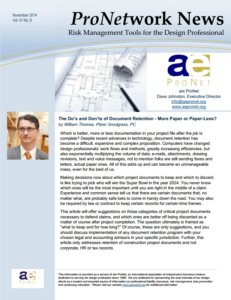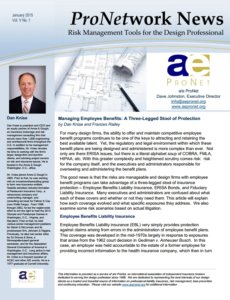 Which is better, more or less documentation in your project file after the job is complete? Despite recent advances in technology, document retention has become a difficult, expensive and complex proposition. Computers have changed design professionals’ work flows and methods, greatly increasing efficiencies, but also exponentially multiplying the volume of data; e-mails, attachments, drawing revisions, text and voice messages, not to mention folks are still sending faxes and letters, actual paper ones. All of this adds up and can become an unmanageable mess, even for the best of us.
Which is better, more or less documentation in your project file after the job is complete? Despite recent advances in technology, document retention has become a difficult, expensive and complex proposition. Computers have changed design professionals’ work flows and methods, greatly increasing efficiencies, but also exponentially multiplying the volume of data; e-mails, attachments, drawing revisions, text and voice messages, not to mention folks are still sending faxes and letters, actual paper ones. All of this adds up and can become an unmanageable mess, even for the best of us.
Making decisions now about which project documents to keep and which to discard is like trying to pick who will win the Super Bowl in the year 2024. You never know which ones will be the most important until you are right in the middle of a claim. Experience and common sense tell us that there are certain documents that, no matter what, are probably safe bets to come in handy down the road. You may also be required by law or contract to keep certain records for certain time frames.
This article will offer suggestions on those categories of critical project documents necessary to defend claims, and which ones are better off being discarded as a matter of course after project completion. The question ultimately is framed as “what to keep and for how long?” Of course, these are only suggestions, and you should discuss implementation of any document retention program with your chosen legal and accounting advisors in your specific jurisdiction. Further, this article only addresses retention of construction project documents and not corporate, HR or tax records.
“Age of Discovery”
Modern construction projects, with all this data, are subject to modern lawsuits. These lawsuits are conducted by increasingly younger, tech savvy and sophisticated lawyers who sometimes make the litigation more about the discovery effort than about the facts of the case. Parties are allowed to submit detailed and specific “requests for production of documents” once in the lawsuit, or issue subpoenas to non-parties. State and federal court discovery rules could require parties to turn over copies of all information they have in their possession related to the project. Continue reading “Document Retention: More Paper or Paper-Less?”








